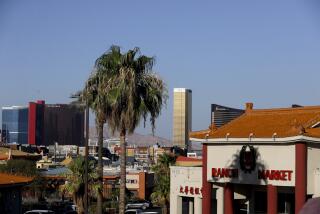Unearthing Ventura’s Chinatown
- Share via
If you gaze toward the ocean from Ventura’s mission, your eyes will sweep over a brick-paved walkway, a park and a parking lot.
Unless you’re avid about local history, though, you’ll miss the saga.
Nothing remains of the thriving Chinese community that occupied the site from the 1860s to 1906, complete with restaurants, groceries, herbalists, opium dens, a Taoist temple and rickety wood-frame houses.
Now the newly formed Ventura County Chinese-American Historical Society wants to memorialize the city’s Chinatown with a statue, a sculpture or a display--something, they say, more distinctive than a plaque.
“Theirs was a story of courage and perseverance,” said Linda Bentz, a member of the group and a researcher specializing in the history of coastal Chinese communities. “These were people who were excluded. They were hard workers trying to escape so many problems in China, and they were treated so badly here. For that alone, they deserve a memorial.”
The group is holding a free walking tour today, hoping to excite city officials and residents about a tribute to this all-but-forgotten community. Participants will meet at 4 p.m. at the Albinger Archeological Museum on Main Street.
Over the years, several excavations have unearthed remnants of the old Chinatown. Crockery, medicine vials, opium pipes, Chinese coins and the like are on exhibit at the Albinger and at the Ventura County Museum of History and Art. Off the Figueroa Street walkway, a narrow Chinese-style security gate stands outside an office entrance.
But except in yellowed newspaper clippings and on occasional tours given by Ventura historian Richard Senate, little is left to indicate the tense times in which Chinatown rose and fell.
Welcomed as cheap labor to lay railroad tracks and haul ore out of gold mines, the Chinese were shunned when jobs grew scarce.
As in other California towns, the Anti-Chinese League in Ventura rallied supporters with brass bands. In 1884, a local newspaper endorsed a plan to concentrate Chinese immigrants in a few square blocks centered on Figueroa Street near the mission: “It is far better to keep the filthy heathen together, where their dirt can be disposed of in bulk. . . .”
The city imposed a $15 quarterly tax on laundries--all of which were Chinese-owned. This was quite a lot of money in an era when a man’s three-piece suit cost all of $8.
City Was Loath to Serve Chinese
The local fire department was so lax about responding to Chinatown fires that the community recruited its own volunteers, summoning them to the fire shed with the sound of a gong. At times, the dozen Chinese volunteers would hustle their wagon outside the neighborhood, fighting the flames before the city’s Monumental Hose, Hook, Fire and Ladder Co. could arrive, according to newspaper accounts of the day.
For years, Charley Yee Hay was the man assigned to unlock the shed. He was the grandfather of Marie Louie, a retired librarian who lives in Camarillo.
Louie, one of the few known descendants of Ventura’s Chinatown, recalls tales of the neighborhood passed down by her mother, who lived there as a child.
“My grandfather was a cook on chuck wagons following the harvest,” she said. “He was paid in gold coins, which he slipped into his boots. When he’d get home, he’d let the kids pull off his boots and the coins would roll all over the place. The kids thought it was great fun.”
Louie’s mother, Nellie Yee Chung, didn’t go to school. Missionaries would drop by the house, teaching the kids to read and giving Bible lessons.
“She had a happy childhood,” Louie said.
The little girl tagged along with her father as he fished for dinner off the pier and bought milk for a dime a pitcher, straight from the farmer. Older women, though, were forced by custom to stay indoors most of the time.
In the years before her death in 1984, Nellie Yee Chung enjoyed car trips to Ventura, although her old neighborhood had long since been demolished and its 200-odd residents scattered.
“She’d get excited when she saw the mission,” Louie said. “In Chinese, she’d call it ‘the Spanish temple.’ ”
Over the last two years, Louie has shared her recollections with Bentz, who also has studied Chinese settlements in Cambria, Santa Barbara and the Channel Islands.
Searching for the Past Through Chinese Eyes
A participant in one of the first Ventura Chinatown archeological digs, Bentz has pursued her work as a labor of love. She has pored through archives for immigration documents and census records. She strolls through Ventura’s old China Alley with a copy of an immigration official’s hand-drawn 1894 map, pointing out the long-gone fan-tan parlor here, the temple there, the employment office across the way.
“I’ve gone through the tax records and the deeds, but what you end up with is the Euro-American point of view of all this,” Bentz said. “I want to know the Chinese point of view: What did you feel? What did you eat? What did the children do?”
By 1906, a few Chinese merchants had prospered. One landowner, Ung Hing, even was able to donate the landmark Ortega Adobe to the city. But many Chinatown residents had left for jobs at the new sugar-beet refinery in Oxnard, and the neighborhood was condemned. The city relocated some of Chinatown’s structures to a lot across Main Street and razed others.
“The home of the Celestial [Chinese] laid bare, is not an inviting spot to look upon,” noted the Ventura Democrat newspaper, “and the purifying process now going on will prove the salvation of Figueroa Street.”
More to Read
Sign up for Essential California
The most important California stories and recommendations in your inbox every morning.
You may occasionally receive promotional content from the Los Angeles Times.











